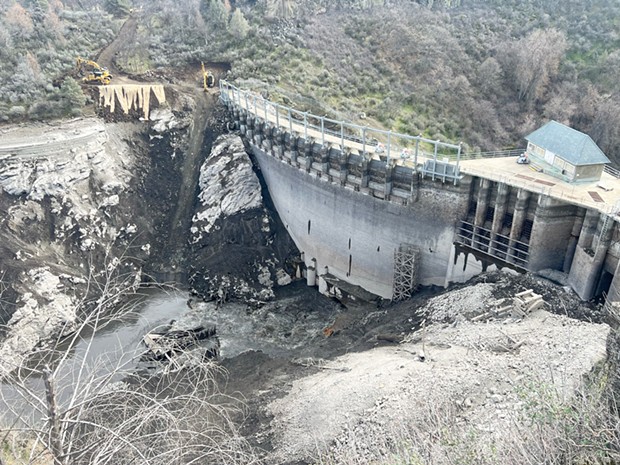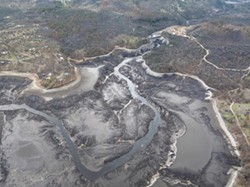'A Very Exciting Time'
The Klamath River finds its channel as dam removal proceeds on schedule
By Thadeus Greenson [email protected] @ThadeusGreenson[
{
"name": "Top Stories Video Pair",
"insertPoint": "7",
"component": "17087298",
"parentWrapperClass": "fdn-ads-inline-content-block",
"requiredCountToDisplay": "1"
}
]
The largest dam removal project in United States history has hit another milestone, completing the initial drawdown of three reservoirs and allowing the Klamath River to find its historic path through their sediment-laden footprints.
During a recent press conference, Mark Bransom, CEO of the Klamath River Renewal Corp., the nonprofit created to oversee the dam removal project, said work is on schedule to see the lower Klamath River's three remaining dams removed by November, restoring it to a free-flowing state not seen in more than 100 years and re-opening hundreds of miles of historic spawning habitat to threatened salmon species. Meanwhile, work has begun to restore the reservoir's footprints with the planting of billions of native plant seeds, some of which are already sprouting.
Pushed forward through decades of advocacy efforts by Klamath River Basin tribes, including the Karuk and Yurok tribes, the Klamath dam removal project was approved by federal regulators in 2022. The scope of the $500 million dam removal plan is massive, as it will see a combined 500 feet of dams removed, with 100,000 cubic yards of concrete, 1.3 million cubic yards of excavated soil and 2,000 tons of demolished steel pulled from the river's path. Removal will be followed by a years-long restoration effort utilizing as many as 20 billion native seeds and 300,000 tree and shrub plugs and starts to replant 2,000 acres of land that had been covered by the three reservoirs created by the dams.
The first dam — Copco 2, the smallest of the four slated for removal at 25 feet and situated between the much larger Copco 1 and Iron Gate dams — was removed in November of 2023. The other three — the 225-foot-tall Copco 1, the 76-foot-tall J.C. Boyle Dam and the 173-foot-tall Iron Gate Dam — are all slated to be removed starting in late May or early June — as soon as spring runoff passes through the system.
"This is a very exciting time for the Klamath River Renewal Project," Bransom said, explaining that while much of 2023 was spent doing preparatory work, 2024's focus is squarely on removal and restoration.
The phased draw-down of the reservoirs began last November with the release of additional flows to lower the reservoirs' water lines, then accelerated in January and early February with more overt interventions. Those included blowing open a 150-foot-long tunnel under Copco 1, blasting a small concrete wall to open a culvert under J.C. Boyle and opening an existing outlet diversion tunnel under Iron Gate.
These drawdowns were timed to coincide with the peak precipitation of winter, the hope being the naturally high water flows would help flush accumulated sediment from the reservoir basins, through the river and out to sea with the least possible environmental impacts.
Bransom said an estimated 17 million to 20 million cubic yards of sediment have accumulated behind the Klamath dams over the last century. Of that, projections show 5 million to 7 million cubic yards are expected to mobilize this year and flow out to the Pacific Ocean.
The timing is also ideal, Bransom said, because there aren't currently adult salmon in the river and most juveniles are safely up its tributaries.
As the river works to find its historic channel through the sediment laden, muddy flats of the reservoir footprints, work is also underway to stabilize that land and ensure it doesn't become overtaken with invasive species.
"We can honestly say now that restoration truly is underway," said Dave Coffman, the Northern California director of Resource Environmental Solutions, the contractor brought in to lead restoration efforts. "We've had revegetation crews out on the reservoir sediments since the 15th of January."
That revegetation work itself is the product of a years-long effort, Coffman explained, adding that teams, primarily from the Yurok Tribe, started collecting native plant seed by hand in 2018, eventually culling a stock of 13 million to 15 million, which were then propagated in nurseries through yield increase grows to a seed source of 17 billion to 20 billion. Those seeds — from 98 different species of plants — have now been sorted into at least five different mixes that are being used, along with acorns, plus and starts, to replant the 2,200 acres of newly exposed land according to various soil conditions.
While most of the seed has so far been put down by hand, Coffman said crews will mobilize helicopters in the coming weeks to replant sections that can't be reached on foot due to "challenging mud conditions." This first phase of replanting, he said, is hoped to be wrapped up by mid-March.
"What we're seeing is the Klamath River is in the location we expected it to be in," after reservoir draw-down, Coffman said. "Vegetation will stabilize the remainder of the sediment that wasn't washed out with drawdown."
Responding to a question about the risk of invasive species overtaking the freshly uncovered reservoir footprints, Coffman said a years-long preparation effort went into preventing that. Noting that the upper Klamath landscape is "chock-full of invasive, exotic vegetation," he said crews have spent years pre-treating the surrounding landscape, using mowers and some limited and targeted herbicide to create buffers for the areas slated for replanting.
After the massive initial replanting effort, Coffman said crews will spend years monitoring the replanted areas, intervening where necessary.
"We'll get out there on our hands and knees if we need to get those [invasive] species out before they go to seed," he said.
As the restoration work continues and crews await spring runoff to flow through the system, Bransom said work is underway to decommission the power houses that PacifiCorp once used to generate electricity.
In related news, the Department of the Interior announced last week that a compromise memorandum of understanding has been forged between Klamath Tribes, the Yurok Tribe, the Karuk Tribe and the Klamath Water Users Association that will improve water supply reliability for upper basin farmers while investing $72 million in ecosystem restoration work and the Klamath Falls National Fish Hatchery.
"The steps we've taken to restore the Klamath River are some of the most significant wins we've seen for our region's ecosystems that have been choked by dilapidated dams and drought for decades," North Coast Congressmember Jared Huffman said in a press release. "Working hand-in-hand with tribes as we take on this ambitious endeavor is unequivocally essential."
Interior Secretary Deb Haaland called the MOU a "critical step."
"Following months of consultation and discussions, we're proud to formalize this partnership with tribes and irrigators and make a shared commitment that will benefit the forests, watersheds, agriculture and abundant populations of migratory bird and fish species that are unique to this basin."
Meanwhile, Bransom and Coffman said they are pleased that all conditions currently being documented in the reservoir footprints and downriver are within the bounds of what scientists have projected. Everything, Bransom said, is on schedule to see a free-flowing lower Klamath River by early October.
"Our goal is to be completely out of the river in time for the fall run and to have reopened some of the upper tributaries to the main stem for fish that might be coming through," Bransom said.
Thadeus Greenson (he/him) is the Journal's news editor. Reach him at (707) 442-1400, extension 321, or [email protected].
Comments
Showing 1-1 of 1
more from the author
-
Deputy Shoots Cutten Shooting Suspect
- Apr 25, 2024
-
Arcata Lowers Earth Flag as Initiative Proponents Promise Appeal
- Apr 25, 2024
-
Officials Weigh in on SCOTUS Case's Local Implications
- Apr 25, 2024
- More »
Latest in News
Readers also liked…
-
Through Mark Larson's Lens
A local photographer's favorite images of 2022 in Humboldt
- Jan 5, 2023
-
'To Celebrate Our Sovereignty'
Yurok Tribe to host gathering honoring 'ultimate river warrior' on the anniversary of the U.S. Supreme Court ruling that changed everything
- Jun 8, 2023

































